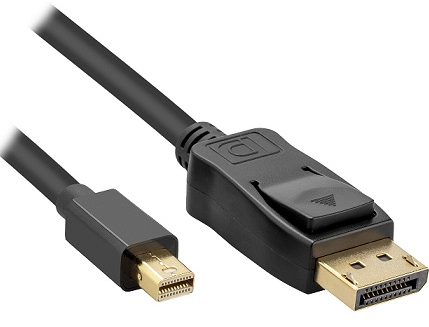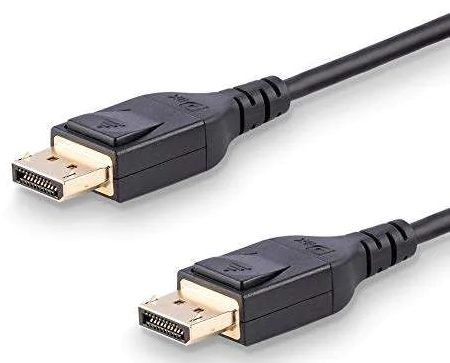While the DisplayPort 1.2 is more than a decade old now, it is still capable enough to beat the latest version of HDMI. But, how does it perform compared to its successor, the DisplayPort 1.4? If you are curious to know what are the major differences between DisplayPort 1.2 and DisplayPort 1.4, we will be discussing them in this article.
DisplayPort 1.2
While most devices out there rely on HDMI ports for video and audio output transmission, when it comes to PCs, using a DisplayPort is preferred. Speaking of the DisplayPort 1.2, it uses 4 lanes to transfer a max bandwidth of 21.6Gbps while the total data rate offered is about 17.28 Gbps which is rather impressive for a decade-old technology. With such good data rates, the DisplayPort 1.2 brings plenty of other advantages such as access to better refresh rates, and features like adaptive sync that helps resolve many issues like screen tearing, and more. However, there are a lot more features that were later on improved in the newer versions of DisplayPort.
DisplayPort 1.4
Although the DisplayPort 1.2 was already overpowering in many aspects, the release of DisplayPort 1.4 brings up a lot more advancement and takes everything to the next level. While the DisplayPort 1.2 offers support for 240Hz output for only up to 1080p resolution, and up to 120Hz output for 4K resolution. The DisplayPort 1.4 can provide 240Hz at 1440p resolution, and up to 120Hz output at 4K resolution. Moreover, the best part about DisplayPort 1.4 cables is that they are also backward compatible, so you can use them with all devices that support only DisplayPort 1.2 connections.
Comparison Table of DisplayPort 1.2 vs DisplayPort 1.4
Performance difference between DisplayPort 1.2 and 1.4?
It is obvious that the DisplayPort 1.4 is much better than DisplayPort 1.2, as it’s a newer version. But, how much of a performance difference between the two? Does the newer DisplayPort 1.4 make the older version obsolete? Not actually, because the DisplayPort 1.2 is still being used widely in entry-level GPUs, and monitors. When you compare DisplayPort 1.2 and 1.4, you will find that DisplayPort 1.2 lacks technologies like DCS and HDCP, which are present on the latest versions of DisplayPort. The DCS technology is basically Display Stream Compression, which allows the connection to handle larger resolutions like 8K without any issues. The DisplayPort 1.4 has a total bandwidth of 32.4 Gbps with a max data rate up to 25.92 Gbps and supports almost 32 audio channels as well. DisplayPort 1.2 has support for only 8 audio channels and delivers 21.6 Gbps bandwidth and 17.28 Gbps data rates. Apart from that, the DisplayPort 1.2 only has support for up to 4K@120Hz resolution, while the DisplayPort 1.4 even supports max resolution up to 8K@60Hz with 10-bit color and HDR. If we talk about other advantages of DisplayPort 1.4, it has HDCP (High-bandwidth Digital Content Protection) 2.2 support which allows you to watch digitally protected content offered by various OTT platforms such as Netflix, Prime Video, etc. With the DisplayPort 1.2 connection, you won’t be able to stream digitally protected content as it will show you nothing, but a black screen.
Which DisplayPort Is Right For You?
As you can see, there are plenty of advantages of using DisplayPort 1.4 connections, the DisplayPort 1.2 is not a bad option either. It’s just that it’s not suitable for a particular user base. If you usually stream 4K or even 8K content and like watching movies through OTT platforms, the DisplayPort 1.4 is the best option to pick as it supports HDCP, which is much needed for online streaming. However, as far as we believe, games don’t require HDCP, so you can comfortably use DisplayPort 1.2 connection in your gaming PC. However, you should take note of the supported resolutions and refresh rates offered by DisplayPort 1.2. If you want to play games at 240Hz, you will be limited to a 1080p monitor, and for 1440p resolution monitors, the refresh rate drops down to 144Hz. So, DisplayPort 1.2 is a good and viable option to pick, but we would still prefer using DisplayPort 1.4 because of its better performance, and is also backward compatible, so it’ll work with all devices, no matter what!
Conclusion: DisplayPort 1.2 vs. 1.4 cables
By now, you must have read all the major differences and features of both DisplayPort 1.2 and DisplayPort 1.4 cables. As we have mentioned earlier, the DisplayPort 1.4 is a much better option as it not only allows you to enjoy high-quality content in up to 8K resolution but also offers up to 240Hz refresh rates with 1440p resolution quality. That said, DisplayPort 1.4 is fit for all users. Whereas the older version, DisplayPort 1.2, is only good if you are using it with your gaming PC and using a monitor with max configuration up to 1440p@144Hz. For all other needs, prefer using DisplayPort 1.4 instead as it’s clearly a better performing option for you.
Does DisplayPort carry audio How to fix DisplayPort to HDMI Best DisplayPort to HDMI adapters
Comment * Name * Email * Website
Δ







![]()